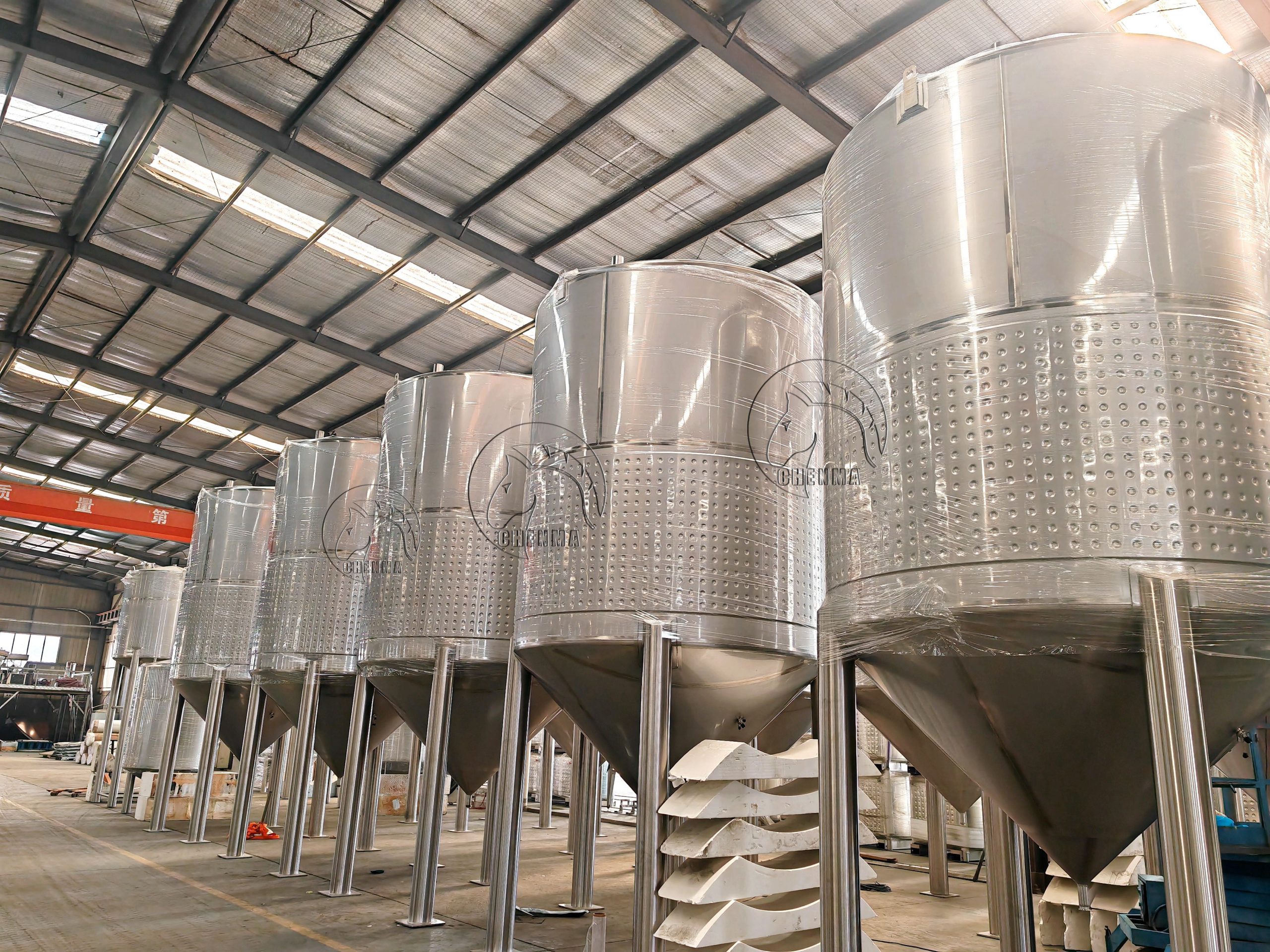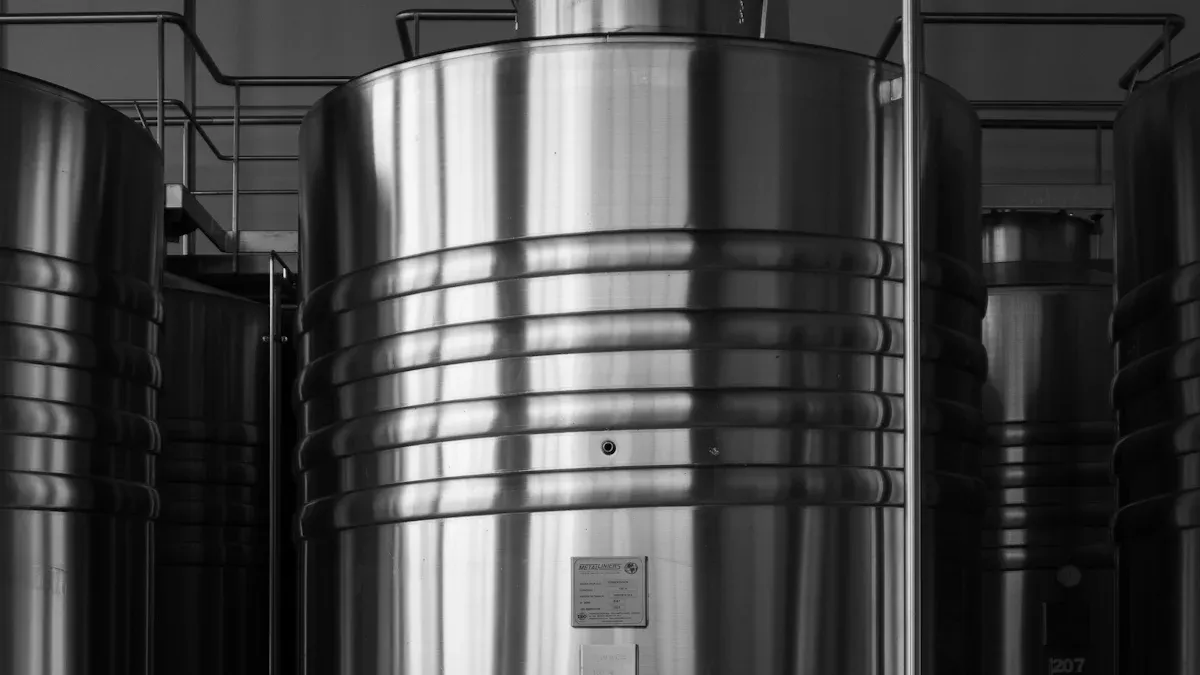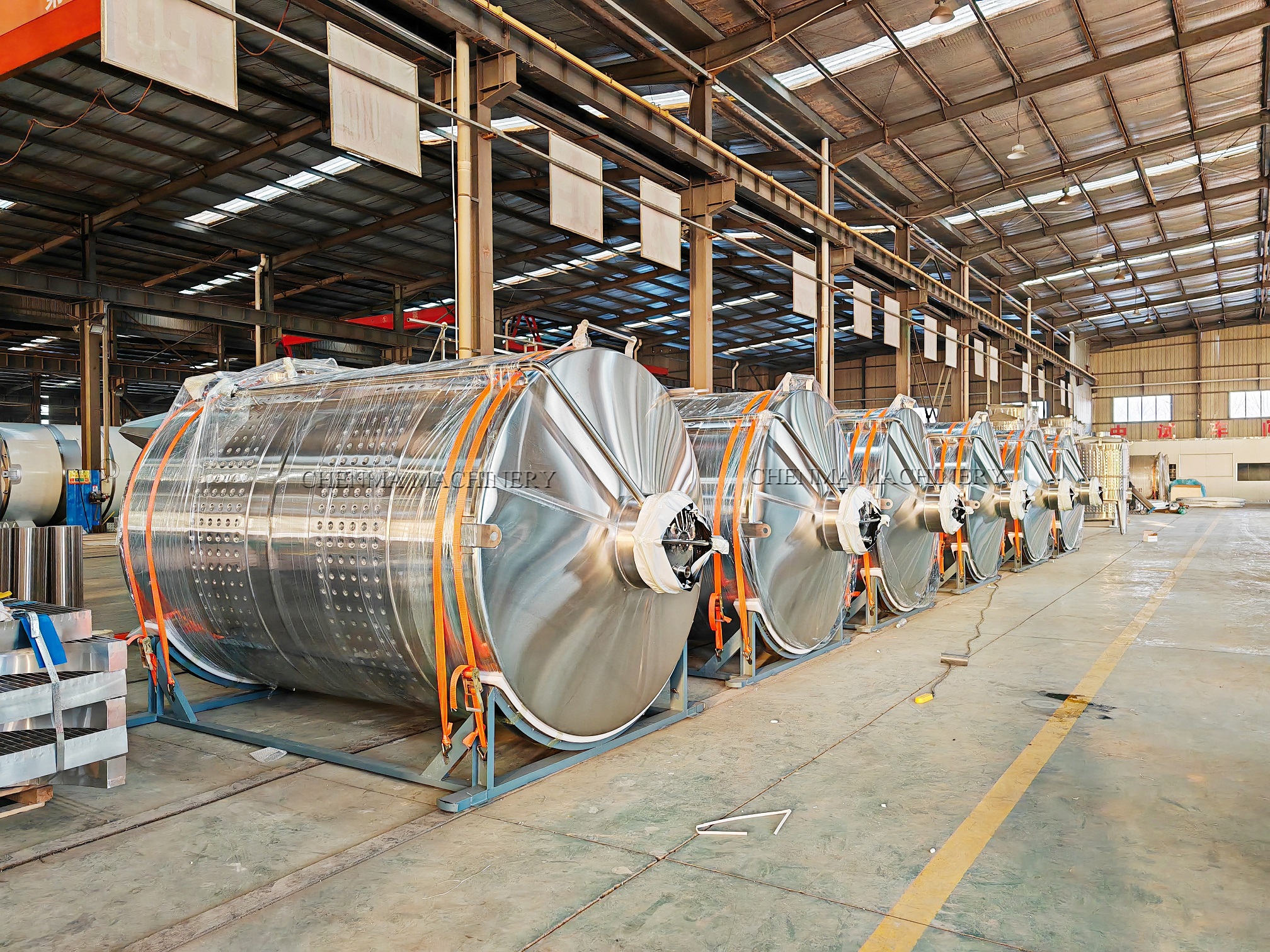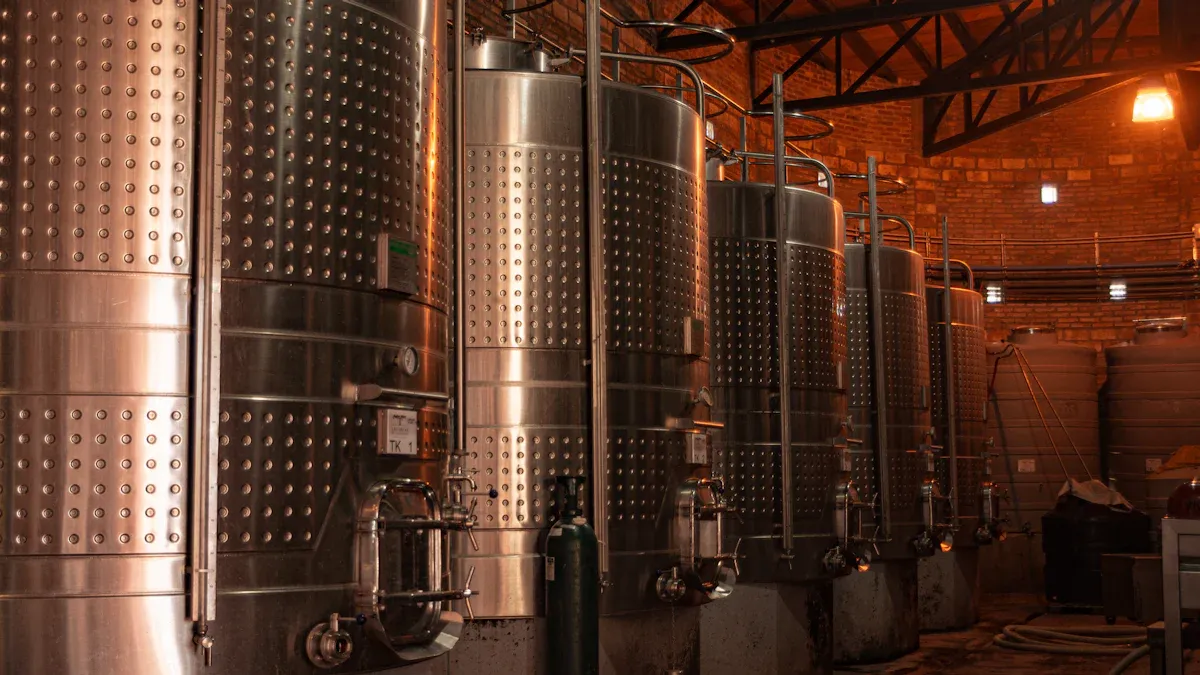
Looking for wine fermentation tanks for sale that won’t break the bank? You want cheap solutions, but you don’t want to sacrifice quality. Chenma gives you the best of both worlds. Their tanks use top-grade stainless steel and come with features like dimpled jackets and floating lids to keep your wine safe. Check out their impressive certifications:
| Certification/Standard | Purpose/Validation Aspect |
|---|---|
| ISO 9001:2015 | Quality management system compliance |
| ISO 14001 | Environmental responsibility |
| OHSAS 18001 / ISO 45001 | Workplace health and safety management |
| CE Certification | Compliance with European health and safety directives |
When you choose Chenma, you get cheap prices, real savings, and peace of mind for your wine projects.
Affordability Matters
Cost Impact
When you look for cheap wine fermentation tanks, you want to know how the price affects your whole operation. The cost of tanks can change your wine production budget in a big way. If you run a small winery or just make wine at home, you might pick a plastic tank because it is cheap. If you run a commercial winery, you probably need bigger, stainless steel tanks. These cost more at first, but they last longer and help you make better wine.
Here’s a quick look at how tank costs stack up for different winery sizes:
| Winery Size | Typical Tank Capacity (Liters) | Approximate Price Range (USD) | Material & Features Impact |
|---|---|---|---|
| Small | 500 – 1,000 | $1,500 – $3,000 (stainless steel), $100 – $400 (plastic) | Smaller tanks keep costs low; plastic is the cheapest but not as strong |
| Medium | 1,000 – 3,000 | $7,000 – $10,000 | Mid-size tanks cost more, but stainless steel gives you better results |
| Large | 5,000+ | $30,000 – $45,000+ | Big, custom tanks cost the most but help you make lots of wine |
Choosing the right tank means you can keep your wine cheap without losing quality. Stainless steel tanks cost more, but they last over 30 years and help you control temperature. That saves money over time and keeps your wine safe.
For Small and Large Producers
You want cheap tanks, but you also want them to fit your needs. Here are the main things that make tanks affordable for both small and large wine producers:
- Material choice matters. Stainless steel tanks cost more, but they save you money in the long run because they last and are easy to clean. Plastic tanks are cheap up front, but they do not last as long.
- Tank size changes the price. Small producers can buy cheap, simple tanks. Large producers pay more for big tanks, but the cost per gallon goes down.
- Tank features make a difference. Open tanks are cheap, but closed tanks with temperature control and automation cost more and help you make better wine.
- Certifications and quality standards add to the price, but they give you safety and value for your wine production.
- The brand and support you get from the supplier can change the price. Well-known brands may cost more, but they offer better help and warranties.
- Think about the total cost. Maintenance, cleaning, and upgrades can add up. Sometimes, paying more for a tank with extra features saves you money later.
- Accessories and fittings cost extra, but they help you work faster and make better wine.
- Pick a tank that matches your goals. If you plan to grow, buy a tank that fits your future needs. That way, you keep your wine cheap and your business ready to expand.
💡 Tip: Always balance the upfront price with long-term savings. Cheap tanks help you start, but strong, well-made tanks help you grow.
Key Features
Material Choices
When you pick a tank for wine making, you have a few main options. Each material changes how your wine turns out and how much you spend. Here’s a quick look at the most common choices:
- Stainless Steel: This is the top pick for many. It lasts a long time, keeps flavors pure, and lets you control temperature. Prices range from $1,200 to $30,000, depending on size and features.
- Oak: Oak tanks add woody or smoky flavors to your wine. They cost more and need extra care. Expect to pay $400–$2,000.
- Concrete: These tanks keep temperatures steady and can give your wine a smooth feel. They cost between $2,500 and $10,000.
- Plastic: If you want something cheap and easy to move, plastic works. It costs $100–$400, but it does not last as long.
- Amphora (Clay): Clay tanks are old-school. They let your wine breathe and are good for small, artisanal wine making.
Here’s a table to help you compare:
| Material | Price Range | Key Benefits |
|---|---|---|
| Stainless Steel | $1,200–$30,000 | Durable, easy to clean, no flavor impact |
| Oak | $400–$2,000 | Adds flavor, traditional feel |
| Concrete | $2,500–$10,000 | Stable temps, unique texture |
| Plastic | $100–$400 | Cheap, lightweight, easy to handle |
| Amphora (Clay) | Varies | Natural, artisanal, flavor neutral |
You can see how stainless steel tanks from different suppliers compare in price and features:
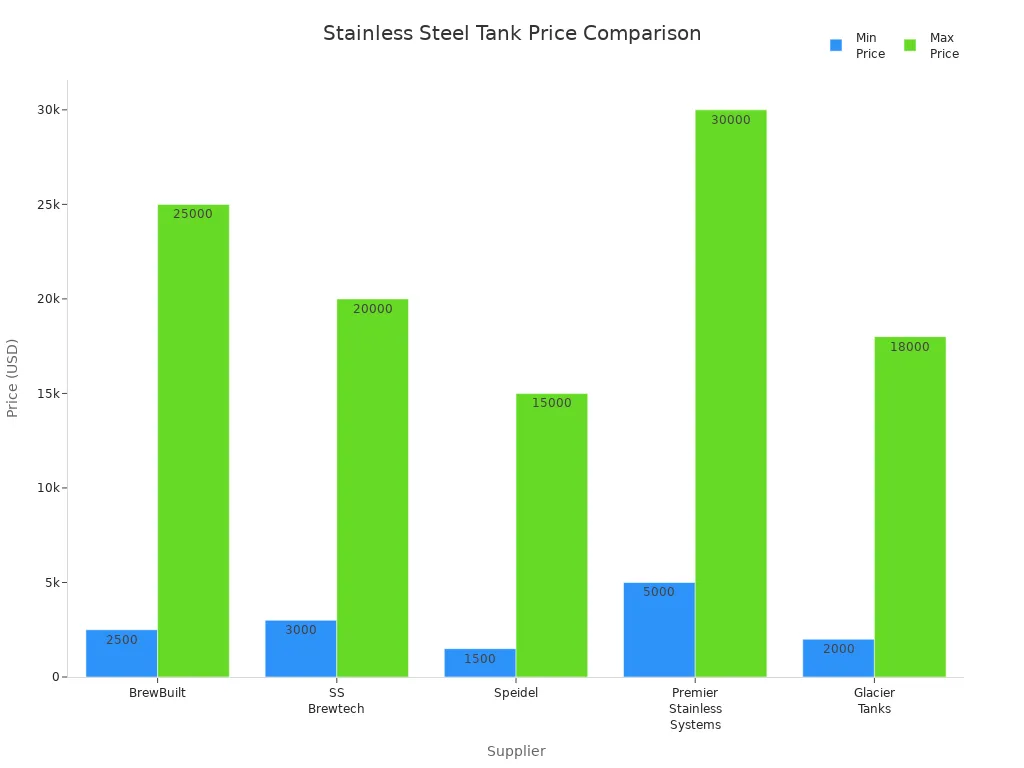
Durability
You want your wine making equipment to last. Stainless steel tanks stand out here. They resist rust and keep their shape for decades. Even though you pay more at first, you save money over time because you do not need to replace them often. If you clean them right, using acid-based cleaners at the right temperature, they stay strong and safe for years. Stainless steel tanks also support the environment because you can recycle them when you finish using them. Oak and plastic do not last as long. Oak can crack or leak, and plastic can wear out or break.
Cleaning Ease
Keeping your tanks clean is key for good wine. Stainless steel makes this job easy. You rinse out the solids, use a cleaner to get rid of tartrates, and finish with a citric acid rinse. This stops germs and keeps your wine safe. You can use spray devices or high-pressure cleaners, so you do not have to scrub by hand. Oak barrels need more work. You must clean them by hand and watch for cracks. Concrete and clay tanks need gentle cleaning, so you do not damage them. If you clean your tanks well, you protect your wine and make sure every batch tastes great.
🧽 Tip: Clean your tanks after every use. This keeps your wine making safe and your wine tasting fresh.
Wine Fermentation Tanks for Sale
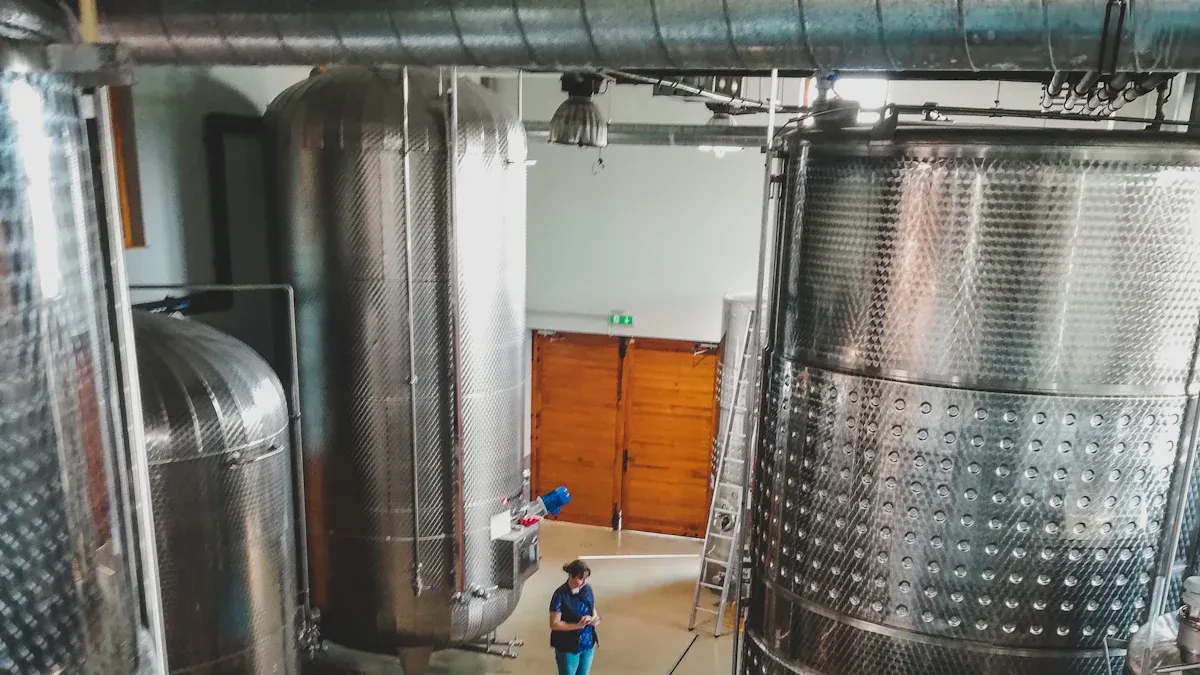
Are you searching for wine fermentation tanks for sale that fit your needs and budget? You have many choices, from small tanks for home use to huge tanks for a commercial winery. Let’s look at what makes Chenma stand out and how other top brands compare.
Chenma Tanks
Chenma offers a wide range of wine fermentation tanks for sale. You can pick from small tanks for a few gallons of wine or order large, custom tanks for your growing business. Chenma builds tanks with high-quality stainless steel. You get strong tanks that last for years and keep your wine safe.
You can ask for special features like:
- Advanced temperature and pressure control
- Smart monitoring systems that track your wine in real time
- Variable volume options for different batch sizes
- Easy-to-clean designs with built-in cleaning systems
Chenma tanks work well for both new winemakers and big wineries. The company holds top certifications like ISO9001 and CE, so you know you are getting safe and reliable equipment. Chenma’s engineers can even design a tank just for you. If you want a tank that matches your space and style, Chenma can help.
Here’s a quick look at how Chenma compares to other leading brands:
| Aspect | Chenma Wine Fermentation Tanks | Other Leading Brands (Speidel, Della Toffola, Letina, Premier Stainless Systems) |
|---|---|---|
| Price | Custom pricing; competitive for features and quality | Premier Stainless Systems offers cost-effective pricing; others vary widely |
| Features | Precision agitators, energy-saving drives, smart monitoring, advanced materials, variable volume, ISO14001 certified | Touch-screen controls, Wi-Fi, glycol cooling, modular designs, energy efficiency, customization |
| Customer Satisfaction | Strong reputation for quality, customization, and sustainability focus | Brands focus on innovation, durability, and tailored solutions |
🏆 Tip: If you want a tank that fits your exact needs, Chenma’s custom solutions make it easy to get started or expand your wine business.
Other Brands
You have many other choices when looking for wine fermentation tanks for sale. Some brands focus on small tanks for home use, while others build giant tanks for a commercial winery. Each brand offers different features, sizes, and price points.
Here’s a table to help you compare the top brands, their tank sizes, and price ranges:
| Brand/Model | Capacity Range | Price Range (Small Tanks) | Price Range (Large Tanks) | Key Features and Notes |
|---|---|---|---|---|
| ALBRIGI | Small to large (compact to commercial) | $1,500 – $7,000 | Up to $30,000 | Durable, advanced temperature control, modular design, built-in cleaning, eco-friendly manufacturing |
| Paso Robles Industrial Wine Tanks | Up to 50,000 liters (large commercial) | N/A | $5,000 – $30,000 | Heavy-duty stainless steel, glycol cooling, insulated walls, customizable options |
| Marchisio Variable Capacity Tanks | 50 liters to 5,000 liters | N/A | N/A | Floating lid, airtight seal, built-in airlock, optional cooling, easy for beginners |
| Chenma Custom Stainless Steel Tanks | Custom sizes (small to large) | N/A | N/A | Highly customizable, advanced controls, integrated cleaning, turnkey solutions, ISO9001 and CE certified |
| JVNW, Inc. | N/A | $2,000 – $6,000 | $10,000 – $25,000 | High customization, cooling systems |
| Paul Mueller Company | N/A | $1,500 – $5,000 | $7,500 – $20,000 | Durable designs, custom options |
| Ziemann Holvrieka | N/A | $3,000 – $7,000 | $15,000 – $30,000 | Industrial-scale tanks |
| Letina | N/A | $1,500 – $4,500 | $5,000 – $15,000 | Variable-capacity tanks |
| Speidel | Variable capacity tanks | N/A | N/A | Flexible for different wine styles, variable capacity |
You can see that prices for small tanks usually start around $1,500 and go up to $7,000. Large tanks can cost $5,000 to $30,000 or more, depending on the brand and features. Some brands, like ALBRIGI and Paso Robles, focus on big tanks for commercial use. Others, like Marchisio and Letina, offer flexible tanks for smaller batches.

When you shop for wine fermentation tanks for sale, think about what matters most to you. Do you want a tank that is easy to clean? Do you need smart controls or just a simple design? Do you plan to grow your wine business? Each brand has something special to offer.
💡 Note: Always check the features and certifications before you buy. A good tank protects your wine and helps you make the best product possible.
Where to Buy
Online Sources
You have many choices when you want to buy wine fermentation tanks online. Online marketplaces make it easy to compare prices and read reviews. If you like to shop for homebrew or home brewing gear, you can find tanks on Amazon, eBay, and Alibaba. These sites offer a wide range of brewing equipment for both beginners and experts. You can check what other people say about the tanks before you buy.
Here’s a quick table to help you see your options:
| Source Type | Examples / Websites | Key Features and Benefits |
|---|---|---|
| Online Marketplaces | Amazon, eBay, Alibaba | Wide selection, price comparison, buyer reviews, competitive shipping, but check seller reliability. |
| Direct Manufacturer | dehuibrewing.com, yolongbrewtech.com | Better pricing, custom tanks, direct support, technical help, and full brewing equipment solutions. |
If you want a tank made just for you, buying from a direct manufacturer is smart. Chenma offers direct sales and custom solutions. You can talk to their team about your homebrew needs or ask for special features for your home brewing setup. Direct manufacturers like Chenma, dehuibrewing.com, and yolongbrewtech.com give you more control over your order. They also help with design, testing, and after-sales support.
🛒 Tip: Always check the seller’s ratings and reviews before you buy brewing equipment online. This helps you avoid problems and get the best value for your homebrew projects.
Local Suppliers
You might want to see the tanks in person before you buy. Local suppliers and brewing equipment shops can help you with that. Many cities have stores that focus on homebrew and home brewing supplies. These shops let you ask questions and get advice from people who know the products. Some local suppliers also offer used tanks, which can save you money if you are just starting with homebrew.
You can also find local brokers who connect you with wineries or breweries selling extra tanks. This is a good way to get quality brewing equipment at a lower price. If you need a custom tank, ask your local supplier if they can order from Chenma or another direct manufacturer.
🏪 Note: Visiting a local shop gives you a chance to see the tanks up close and talk to experts about your home brewing plans.
Pros and Cons
Stainless Steel vs. Plastic
When you choose fermenters for wine making, you face a big decision: stainless steel or plastic? Each type has its own strengths and weaknesses. Here’s what you need to know:
- Stainless steel fermenters last a long time. They resist rust and damage, so you can use them for many years. You get a smooth surface that makes cleaning easy. This helps keep your wine safe from bacteria.
- These fermenters let you control the temperature. You can use cooling jackets or heating systems to keep your wine at the perfect level. This is important for making high-quality wine.
- Stainless steel does not change the taste of your wine. It keeps flavors pure and fresh. You pay more at first, but you save money over time because you do not need to replace them often.
- Plastic fermenters cost less and are easy to move. They work well for small batches or if you are new to wine making. Most plastic fermenters use food-grade materials, so they are safe for your wine.
- Plastic can scratch easily. Scratches can trap bacteria, which makes cleaning harder. Over time, plastic may absorb flavors or smells from your wine. This can change the taste of your next batch.
- Plastic fermenters do not last as long as stainless steel. You may need to buy new ones after a few years.
📝 Tip: If you want to make wine for many years or plan to grow your wine making, stainless steel fermenters give you better value and safer results.
New vs. Used
You also need to decide if you want new or used fermenters for your wine making. Both choices have benefits and drawbacks.
| Option | Pros | Cons |
|---|---|---|
| New | Clean, reliable, latest features, warranty | Higher price, longer delivery times |
| Used | Lower cost, quick availability | May have wear, no warranty, unknown history |
New fermenters give you peace of mind. You know they are clean and ready for wine making. You also get a warranty and support from the seller. Used fermenters can save you money, but you need to check them carefully. Look for signs of damage or leftover smells from old wine. Sometimes, used fermenters need repairs or extra cleaning before you can use them.
💡 Note: Always ask about the history of used fermenters. Make sure they are safe and clean for your wine making plans.
Savings Tips
Deals and Discounts
You want to save money when you buy wine fermentation tanks. The best way to find cheap tanks is to look for deals and discounts. Many suppliers offer special prices during certain times of the year. Watch for sales during grape harvest season, Black Friday, and end-of-year clearances. These times often bring the lowest prices.
Sign up for newsletters from trusted suppliers. You will get alerts about flash sales and limited-time offers. Some companies give you a discount just for joining their mailing list. Use online price comparison tools to check prices from different sellers. This helps you spot the most cheap options fast.
💡 Tip: Always read customer reviews before you buy. Real feedback can help you avoid problems and find the best cheap tanks.
Negotiation
You do not have to accept the first price you see. Many suppliers expect you to ask for a better deal. Start by getting quotes from several sellers. Ask if they can lower the price, especially if you plan to buy more than one tank. You can also ask about discounts for bundling tanks with other equipment or for reducing shipping fees.
If you see a tank you like but want a better price, talk to the seller. Sometimes, just asking can get you a cheap upgrade or free accessories. Always request a full quote that includes shipping and any extra fees. This way, you know the real cost before you agree to buy.
Bulk Buying
Buying in bulk is a smart way to get cheap wine fermentation tanks. When you order several tanks at once, suppliers often give you a lower price per tank. You might also get perks like free shipping or extra fittings. Bulk buying works well if you run a winery or want to team up with other winemakers.
Check if the supplier offers bulk discounts or special packages. Some companies even launch new products with deals for large orders. Always make sure the tanks meet quality standards like ISO9001 and CE. Cheap tanks are great, but you want them to last and keep your wine safe.
Homebrew Options
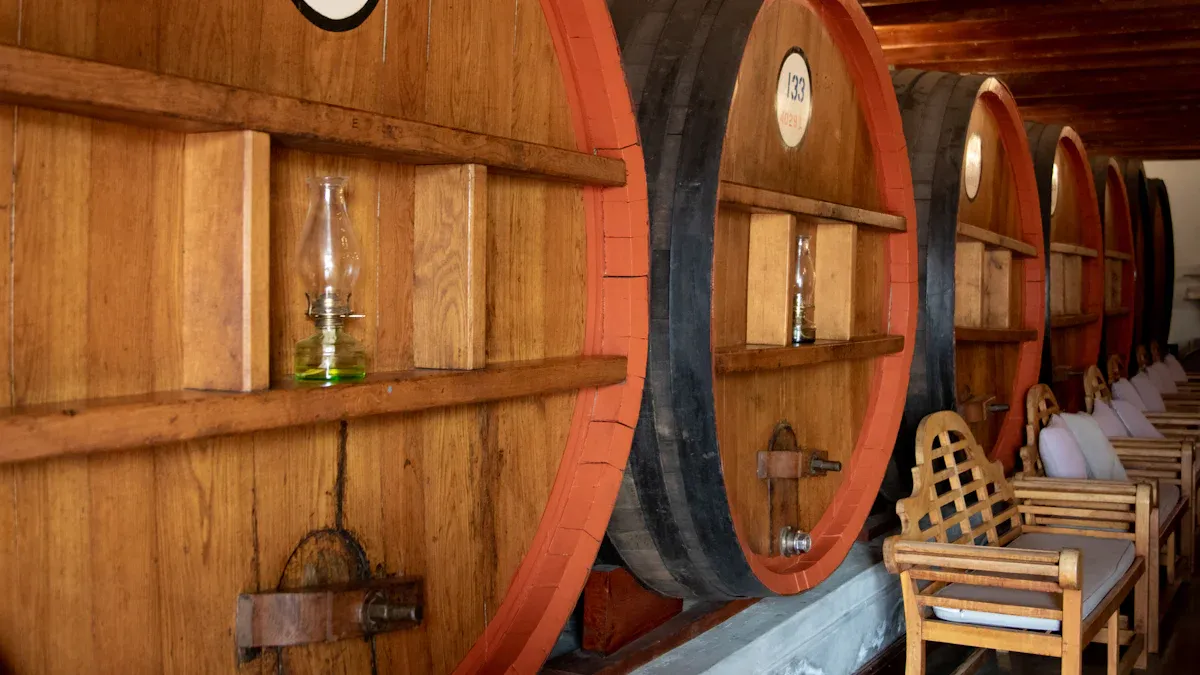
If you love making wine at home, you want the right tools for the job. The world of homebrew has grown a lot, and now you can find tanks and gear that fit any space or budget. Let’s look at the best options for home brewing and see which tanks work best for hobbyists and small-scale producers.
Small Tanks
Small tanks make homebrew easy and fun. You can find stainless steel conical fermenters that help you manage yeast and keep your wine clean. These tanks last a long time and are simple to clean. Many home brewing fans choose tanks that hold between 5 and 20 gallons. Stainless steel tanks cost more at first, usually between $500 and $4,000, but they last for years and keep your wine safe. If you want something lighter, you can try plastic fermenters. They cost less and are easy to move, but they do not last as long as stainless steel.
Here are some popular small tank choices for home brewing:
- GW Kent: Offers variable capacity stainless steel tanks from 150L up to 2150L. You can pick flat bottom, slope bottom, or glycol-jacketed tanks for better temperature control.
- MoreWine: Sells small stainless steel tanks and plastic fermenters for homebrew. Their tanks are easy to clean and come in many sizes.
- Ace Stills: Known for affordable home brewing supplies, including small tanks and brewing equipment for beginners.
- Homebrewing.com: Offers a wide range of home brewing equipment, from entry-level fermenters to advanced stainless steel tanks.
🏠 Tip: Start with a small tank if you are new to home brewing. You can always upgrade as your homebrew skills grow.
Entry-Level Choices
When you start home brewing, you want tanks that are easy to use and don’t cost too much. Entry-level fermenters like the FastFerment Conical Fermenter and FermZilla All Rounder are great picks. FastFerment costs under $100 and is lightweight, so you can move it around your home brewing space. FermZilla costs between $100 and $200 and lets you see your wine as it ferments. Both are easy to clean and perfect for homebrew beginners.
If you want to invest a bit more, COFF offers the Mini Brewmaster Series. These stainless steel tanks start at $300 and give you better temperature control and longer life. Many home brewing fans trust COFF because their tanks last and keep wine flavors pure.
Here’s a quick table to compare some entry-level tanks:
| Fermentation Tank | Price Range | Key Features |
|---|---|---|
| FastFerment Conical Fermenter | Under $100 | Lightweight, easy for beginners, collection ball |
| FermZilla All Rounder | $100-$200 | Pressure-rated, clear body, wide opening |
| COFF Mini Brewmaster Series | $300-$500 | Stainless steel, compact, temperature control |
You can find these tanks and more at home brewing supplies stores or online shops like MoreWine and Homebrewing.com. No matter which tank you pick, make sure it fits your home brewing needs and space.
🍷 Note: The right tank makes homebrew simple and fun. Pick one that matches your style and budget, and enjoy the process of making your own wine at home.
30 Gallon Fermenters
Are you looking for a 30 gallon fermentation vessel that fits your growing wine or beer project? This size works great for mid-size production. It gives you enough space to experiment with bigger batches, but it’s still easy to handle in most home or small business setups.
Let’s look at what’s available on the market right now:
| Brand | Size Available | Availability | Key Features / Customer Feedback | Recommendation for Mid-Size Production |
|---|---|---|---|---|
| Blichmann WineEasy™ | 30 Gallon | Sold out, 2-6 week delay | Innovative design, easy to use, no transfers needed, reduces contamination, highly effective | Most recommended brand, despite current stock issues |
| FermZilla All Rounder | 7.9 Gallon | In stock | Affordable, easy to clean, good reviews, but significantly smaller than 30 gallons | Not suitable for mid-size production due to smaller capacity |
You can see that Blichmann WineEasy™ is the top pick for 30 gallon fermenters, but you might have to wait a few weeks for delivery. If you want something right away, you may need to look at other brands or consider custom orders.
Stainless Steel
Stainless steel 30 gallon fermenters stand out for their strength and long life. You get a vessel that resists rust, dents, and scratches. Cleaning is simple because the smooth surface keeps bacteria away. Many winemakers and brewers love stainless steel because it gives you better control over temperature and pressure. This means your wine or beer turns out the same every time. The upfront cost is higher, sometimes between $3,000 and $15,000 for premium models, but you save money in the long run. These tanks can last 15 to 20 years or more. If you want a reliable 30 gallon fermentation vessel for mid-size batches, stainless steel is a smart choice.
Plastic
Plastic fermenters cost less and are much lighter. You can move them around without much effort. They work well if you want to save money or need something easy to handle. However, plastic scratches easily, and those scratches can trap bacteria. Cleaning takes more effort, and the vessel may not last as long. Over time, you might notice changes in taste or quality. Most users find plastic fermenters good for short-term use or for starting out, but they often switch to stainless steel as their needs grow.
📝 Tip: If you plan to make wine or beer for many years, invest in stainless steel. If you just want to try out mid-size batches, plastic can help you get started without spending too much.
Quality and Warranty
Certifications
When you shop for wine fermentation tanks, you want to know they meet strict safety and quality rules. Certifications show you that a tank is safe for your wine and built to last. Here are some of the most important certifications you should look for:
- ASME Boiler and Pressure Vessel Code: This matters if you need a tank that can handle pressure.
- FDA Food Contact Compliance: This means the tank materials are safe for food and drinks.
- TTB Requirements: These rules help you follow U.S. laws for making wine and beer.
- 3-A Sanitary Standards: Tanks with this mark are easy to clean and keep your wine safe from germs.
- ISO 9001 Quality Management System: This shows the company follows strong quality rules when making tanks.
- NSF/ANSI 51: This means the tank uses safe materials for food equipment.
- Brewers Association Guidelines: These help you make sure your tank fits industry best practices.
- Master Brewers Association Best Practices: These standards help you get the best results in your wine making.
Some manufacturers, like Roben MFG, always meet or even go beyond these standards. When you see these certifications, you know you can trust the tank for your wine.
✅ Tip: Always check for certifications before you buy. They help you avoid problems and keep your wine safe.
Warranty Coverage
Warranty coverage gives you peace of mind. You want to know your tank will last and that you can get help if something goes wrong. Different companies offer different types of warranties. Here’s a quick look at how they compare:
| Manufacturer/Supplier | Warranty Coverage | Warranty Period | Coverage Details | Additional Support |
|---|---|---|---|---|
| Most Suppliers | Defects in materials and workmanship | ~5 years | Focus on stainless steel tank durability (SS 304/316) | N/A |
| Chenma | Tank and core components | 3 years | Covers both tank and important parts | Free replacement parts, technical service |
Most suppliers give you about five years of coverage for problems with the tank’s materials or how it was made. Chenma offers a three-year warranty, but it covers both the tank and its core parts. You also get free replacement parts and technical help if you need it.
🛡️ Note: Always read the warranty details. A good warranty can save you money and stress if you ever need repairs or support.
Shipping
Costs
Shipping wine fermentation tanks can feel tricky, but you can plan ahead when you know what to expect. The cost depends on the size of your tank, how much it weighs, and where you want it delivered. Small tanks or parts usually ship for less. Large tanks need special trucks and careful handling, so they cost more.
Here’s a quick look at typical shipping costs:
| Shipping Size/Type | Typical Cost Range (USD) | Key Factors Affecting Cost |
|---|---|---|
| Small components (LTL, regional) | $150–$400 | Weight, size, regional delivery, LTL shipping |
| Mid-sized systems on pallets (LTL, national) | $400–$1,000 | Larger size, national distance, palletized freight |
| Full brewhouse or tank shipments (FTL or flatbed) | $1,200+ | Oversized tanks, heavy weight, full truckload or flatbed needed |
You might see extra fees if your delivery site is hard to reach or in a busy city. Sometimes, you need a liftgate or special appointment for delivery. Fragile tanks may need extra crating or careful handling, which can add to the price. The shipping method matters too. LTL (less-than-truckload) works for small items, while FTL (full truckload) or flatbed trucks are best for big tanks.
🚚 Tip: Always ask your supplier for a full shipping quote before you buy. This helps you avoid surprises and budget better.
Delivery Times
Delivery times for wine fermentation tanks can change based on a few things. If you order a small tank or part, you might get it in a week or two. Larger tanks take longer because they need special trucks and careful planning.
- Small tanks or parts: Usually arrive in 7–14 days.
- Mid-sized tanks: Often take 2–4 weeks, especially if shipped across the country.
- Large or custom tanks: Can take 4–8 weeks or more, depending on production and shipping schedules.
Weather, holidays, and how far you live from the supplier can also affect delivery. If you order a custom tank, you may need to wait for it to be built before it ships. Always check with your supplier for the latest updates.
📦 Note: Plan your order early, especially if you need your tank for a busy season. This gives you time to set up and start making wine without delays.
Reviews
User Experiences
You probably want to know what other people think before you buy a wine fermentation tank. User reviews give you a clear picture of what works and what doesn’t. Many homebrew fans say stainless steel tanks last a long time and resist corrosion. You get precise temperature control, which is important for both red and white wine. Cleaning is easy because the smooth surface and bottom drain valves help you remove every bit of leftover wine. People love features like variable volume tanks and floating lids. These options help you keep your wine fresh and safe.
Here’s what users like most:
- Durability and corrosion resistance, especially with stainless steel tanks.
- Easy cleaning and maintenance, thanks to smooth surfaces and smart drainage.
- Customization options, such as floating lids and variable volume tanks.
- Good customer support and warranties that make ownership stress-free.
Home brewing beginners and experts both mention that responsive after-sales service makes a big difference. If you run into a problem, quick help from the supplier keeps your homebrew project on track.
😊 Tip: If you want a tank that fits your homebrew style, look for brands that offer customization and strong support.
Common Issues
You might face some challenges with wine fermentation tanks, especially if you’re new to home brewing. Most problems come from managing fermentation, not the tank itself. Customers often report slow or stalled fermentations because of temperature changes. If the temperature swings too much, yeast can go dormant and stop working. You need to keep your wine at the right temperature to avoid these issues.
Other common problems include:
- Difficulty managing yeast nutrition, since testing for amino acids and nitrogen needs special equipment.
- Barrel fermentations can overheat, causing off-flavors like hydrogen sulfide.
- Persistent bubbling after fermentation may mean CO2 is still escaping or secondary fermentation is happening.
- Clay tanks need careful cleaning to avoid damage, but stainless steel tanks are much easier to maintain.
Homebrew makers say patience is key. Don’t rush racking or bottling. Monitor specific gravity and stabilize your wine before moving to the next step. If you want fewer headaches, stainless steel tanks help you control temperature and make cleaning simple.
⚠️ Note: Always check your fermentation temperature and clean your tank after every batch. This keeps your home brewing safe and your wine tasting great.
You have great options when searching for wine fermentation tanks for sale. Experts suggest you look for certified suppliers, like Chenma, who offer stainless steel tanks with ISO9001 and CE certifications. Check user reviews and compare features, such as temperature control and easy cleaning. Use savings tips, like negotiating and buying in bulk, to get the best deal. If you want reliable wine equipment, explore trusted brands and plan for your future growth.
🏆 Choose tanks that fit your space, budget, and wine goals for lasting success.
FAQ
How do I choose the right size wine fermentation tank?
Think about how much wine you want to make. Small home batches need tanks from 5 to 30 gallons. Commercial wineries often use tanks over 1,000 liters. Always pick a tank that matches your production goals.
Can I use a plastic tank for wine fermentation?
Yes, you can use plastic tanks for small batches or home winemaking. They cost less and are easy to move. Stainless steel tanks last longer and keep your wine safer, especially for bigger batches.
How do I clean a stainless steel wine fermentation tank?
First, rinse the tank with warm water. Next, use a food-safe cleaner to remove residue. Finish with a citric acid rinse. Stainless steel tanks clean easily and help prevent bacteria from growing.
Where can I buy certified wine fermentation tanks?
You can buy certified tanks from direct manufacturers like Chenma, online marketplaces, or local brewing supply stores. Always check for certifications like ISO9001 and CE to make sure your tank meets safety and quality standards.

